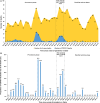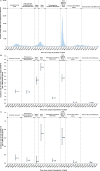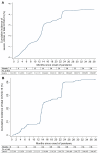Turning point in COVID-19 severity and fatality during the pandemic: a national cohort study in Qatar
- PMID: 40017867
- PMCID: PMC11812731
- DOI: 10.1136/bmjph-2023-000479
Turning point in COVID-19 severity and fatality during the pandemic: a national cohort study in Qatar
Abstract
Objective: To assess the evolution of COVID-19 severity and fatality in a unique setting that consistently applied, throughout the pandemic, rigorous and standardised criteria for defining severe COVID-19 outcomes.
Methods and analysis: We conducted a national cohort study on 312 109 Qatari citizens to investigate incidence of severe, critical or fatal COVID-19 classified according to the WHO criteria between 28 February 2020 and 21 April 2023. Incidence rates for severe, critical or fatal COVID-19 were estimated during the pre-omicron phase, first omicron wave, combined phases and throughout the pandemic.
Results: Cumulative incidence of severe, critical or fatal COVID-19 after 3.14 years of follow-up was 0.45% (95% CI 0.43% to 0.47%). Incidence rate for severe, critical or fatal COVID-19 throughout the pandemic was 1.43 (95% CI 1.35 to 1.50) per 1000 person years. In the pre-omicron phase, first omicron wave, and combined phases, it was 2.01 (95% CI 1.90 to 2.13), 3.70 (95% CI 3.25 to 4.22) and 2.18 (95% CI 2.07 to 2.30) per 1000 person years, respectively. The post-first omicron phase saw a drastic drop to 0.10 (95% CI 0.08 to 0.14) per 1000 person years, a 95.4% reduction. Among all severe, critical and fatal cases, 99.5% occurred during the primary infection. Cumulative incidence of fatal COVID-19 was 0.042% (95% CI 0.036% to 0.050%), with an incidence rate of 0.13 (95% CI 0.11 to 0.16) per 1000 person years. In the post-first omicron phase, incidence rate of fatal COVID-19 decreased by 90.0% compared with earlier stages. Both severity and fatality exhibited an exponential increase with age and a linear increase with the number of coexisting conditions.
Conclusion: The conclusion of the first omicron wave was a turning point in the severity of the pandemic. While vaccination and enhanced case management reduced severity gradually, the rapid accumulation of natural immunity during the first omicron wave appears to have played a critical role in driving this shift in severity.
Keywords: COVID-19; SARS-CoV-2; epidemiology.
Copyright © Author(s) (or their employer(s)) 2023. Re-use permitted under CC BY-NC. Published by BMJ.
Conflict of interest statement
AAB has received institutional grant funding from Gilead Sciences unrelated to the work presented in this paper.
Figures






References
LinkOut - more resources
Full Text Sources
Miscellaneous
